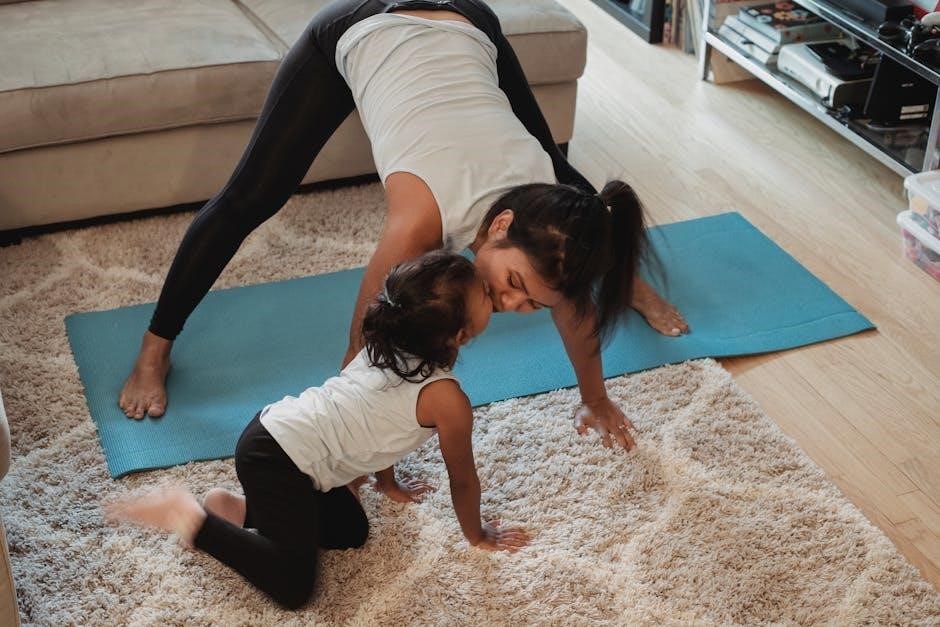Ear stretching is a popular body modification involving enlarging pierced earlobes, often for aesthetic reasons. This guide helps you understand sizes, methods, and best practices for safe stretching.
1.1 What is Ear Stretching?
Ear stretching is a body modification process where the earlobe is gradually enlarged to accommodate larger jewelry. It involves using tools like tapers or plugs to create a larger hole, often measured in gauges. This practice is popular for aesthetic and cultural reasons, allowing individuals to showcase unique styles and personal expression.
1.2 Popularity and Cultural Significance
Ear stretching has gained global popularity, particularly among younger generations, as a form of self-expression and cultural identity. Originating in ancient practices, it symbolizes status, spirituality, or belonging in various cultures. Today, it’s embraced for aesthetic appeal, with diverse jewelry options enabling individuals to showcase unique styles and personal identity.

Understanding Ear Stretching Sizes
Ear stretching sizes are measured in gauges, millimeters, or inches, with smaller numbers representing larger sizes. Understanding these measurements is crucial for choosing the right jewelry and ensuring proper healing.
2.1 Definition of Gauge Sizes
Gauge sizes measure the thickness of ear jewelry, with smaller numbers indicating larger diameters. For example, a 16g is thicker than an 18g. This system helps determine jewelry fit and stretching progress, ensuring compatibility and comfort for various ear sizes and styles.
2.2 How Gauge Sizes Work
Gauge sizes are inverse, meaning smaller numbers represent larger diameters. For example, 16g is thicker than 18g. This system helps track stretching progress and choose appropriate jewelry, ensuring proper fit and comfort as sizes increase. Understanding this inverse relationship is key to selecting the right tools and jewelry for safe stretching.
2.3 Importance of Proper Sizing
Proper sizing ensures a safe and successful stretching process. Using the right gauge prevents tissue damage, promotes healing, and avoids complications. Incorrect sizes can lead to discomfort or tears, making it crucial to follow a gradual progression and use reliable measurement tools for accurate sizing and optimal results.
Ear Stretching Size Chart
This chart provides conversions between gauge, millimeters, and inches, helping you track progress and choose jewelry. It’s essential for planning and achieving your desired ear stretching size accurately.
3.1 Gauge to Millimeter Conversion
Understanding gauge to millimeter conversions is crucial for ear stretching. The smallest gauge, 20g, equals 0.81mm, while larger sizes like 00g correspond to 10mm. This guide helps you accurately measure and track your progress, ensuring safe and effective stretching to achieve your desired earlobe size seamlessly.
3.2 Gauge to Inch Conversion
Gauge to inch conversions are essential for precise sizing. A 12g gauge equals 5/64 inch, while a 10g is 3/32 inch. Larger sizes like 00g convert to 10mm, or approximately 0.393 inches. This guide helps you accurately measure and track your ear stretching progress for safe and stylish results.
3.3 Standard Size Ranges
Standard ear stretching sizes range from 20g (0.81mm) to 00g (10mm), with larger sizes measured in inches or millimeters. Common sizes include 14g (1.6mm), 8g (3mm), and 0g (8mm). Beyond 00g, sizes progress in increments like 1/2 inch or 12mm, accommodating individual preferences and goals.
Choosing the Right Size
Selecting the correct size involves understanding gauge measurements, measuring your ear, and setting realistic goals. Proper sizing ensures comfort, prevents damage, and supports the healing process during stretching.
4.1 How to Measure Your Ear
Measuring your ear involves using a gauge chart or calipers to determine current size. Insert jewelry through the piercing and align it with the chart to find your gauge. Start with smaller sizes and gradually increase as you stretch to avoid tissue damage and ensure a smooth process.
4.2 Starting Sizes for Beginners
Beginners typically start with smaller gauges, such as 14g or 16g, after an initial piercing. Using high-quality starter kits ensures safety and comfort. Avoid starting with larger sizes, as this can lead to discomfort or complications. Gradual progression is key to successful ear stretching and maintaining healthy tissue.
4.3 Understanding Size Progression
Ear stretching progresses from smaller gauges to larger ones, with sizes increasing gradually. Start at 14g or 16g and move to 12g, 10g, and so on. Beyond 00g, sizes switch to millimeters or inches. Proper progression ensures healthy tissue and prevents damage. Use a size chart to track your journey effectively.
The Stretching Process
Ear stretching involves gradually enlarging pierced lobes using tools like tapers and plugs; It requires patience, proper technique, and consistent aftercare to ensure safe and effective results.
5.1 Step-by-Step Guide to Stretching
- Prepare by cleaning your ear and tools with antibacterial soap.
- Use a taper or plug to gradually enlarge the piercing.
- Apply lubrication, like jojoba oil, to reduce discomfort.
- Start with smaller gauges and progress slowly.
- Allow healing time between stretches to avoid damage.
- Follow proper aftercare to promote healing and prevent complications.
5.2 Tools and Supplies Needed
Essential tools include tapers, plugs, and lubrication like jojoba oil. Use a gauge chart for accurate sizing and sterile supplies to minimize infection risks. Additional items like cleaning solutions and aftercare products ensure proper healing and maintenance during the stretching process.
5.3 Aftercare and Healing Tips
- Soak stretched ears in saline solution daily to promote healing.
- Avoid harsh chemicals like alcohol or hydrogen peroxide.
- Keep jewelry clean and avoid tight clothing that may irritate the area.
- Massage ears with jojoba oil to maintain elasticity and reduce discomfort.
- Wear the correct size jewelry to prevent stretching setbacks.
Safety and Best Practices
Always use sterile tools and follow proper stretching techniques to avoid complications. Prioritize patience, as rushing can cause damage. Ensure jewelry fits comfortably and is made from safe materials.
6.1 Risks and Complications
Ear stretching carries risks like infections, scarring, and tissue damage. Over-stretching can lead to blowouts or tearing. Improper tools or abrupt size jumps increase these risks. Ensuring clean practices and gradual stretching minimizes complications, promoting safe and healthy ear modification experiences.
6.2 How to Avoid Common Mistakes
To avoid common mistakes, start with smaller gauges and progress gradually. Use high-quality tools like tapers and plugs, and prioritize proper aftercare. Avoid rushing the process, as this can cause injury. Research and plan your stretching journey to ensure safety and achieve desired results effectively.
6.3 Importance of Patience
Patience is crucial in ear stretching as it allows the skin to heal properly between size increments. Rushing the process can lead to damage or discomfort. Allowing adequate healing time ensures a smooth and successful stretching journey, promoting healthy tissue and preventing complications.
Jewelry for Stretched Ears
Jewelry for stretched ears includes plugs, tunnels, and weights, available in various materials like glass, wood, and acrylic. Proper sizing ensures comfort and style, enhancing your stretched ear look.
7.1 Types of Jewelry for Stretched Ears
Explore various jewelry options for stretched ears, including plugs, tunnels, and weights. Plugs are solid, while tunnels feature a hollow center. Weights add style with dangling designs. Materials like glass, wood, and acrylic offer diversity in aesthetics and comfort for different ear sizes and personal preferences.
7.2 Choosing the Right Jewelry Size
Selecting jewelry that fits your stretched ears properly is crucial. Use a gauge-to-millimeter chart to match your ear size with the jewelry. Ensure the jewelry is snug but not tight, allowing for comfort and proper healing. Correct sizing prevents discomfort and supports long-term ear health and aesthetics effectively.
7.3 Material Options for Jewelry
Choose jewelry materials based on comfort, durability, and style. Common options include stainless steel, titanium, glass, wood, and acrylic. Stainless steel and titanium are hypoallergenic, ideal for sensitive skin. Glass and acrylic are lightweight and affordable, while wood offers a natural aesthetic. Select materials suitable for your lifestyle and healing stage.
Advanced Stretching Techniques
Explore advanced methods for ear stretching, including techniques beyond basic sizing, ensuring safety and proper aftercare for successful results and maintaining ear health.
8.1 Stretching Beyond 00 Gauge
Stretching beyond 00 gauge involves transitioning to millimeter or inch measurements. It requires patience, as larger sizes can cause permanent changes. Using high-quality tools and following proper aftercare ensures healthy progression and prevents complications.
8.2 Using Tapers vs. Plugs
Tapers and plugs are essential tools for ear stretching. Tapers are used to gradually increase size, while plugs hold the desired gauge. Choosing the right material and size ensures comfort and prevents damage to the earlobe during the stretching process.
8.3 Non-Traditional Stretching Methods
Non-traditional methods include using weights or scalpels for faster results. These techniques carry higher risks and require professional guidance. Weight stretching applies gradual tension, while scalpels create larger openings instantly. Safety and precision are crucial to avoid complications and ensure proper healing in advanced stretching practices.

Healing and Maintenance
Proper aftercare is crucial for healing stretched ears. Clean with saline solution daily, avoid tight clothing, and monitor for redness or swelling; Patience ensures healthy, long-lasting results.
9.1 Aftercare Routine
A proper aftercare routine for stretched ears involves daily cleaning with saline solution, avoiding tight clothing, and monitoring for signs of irritation. Keep the area dry and avoid submerging in water. Regularly cleaning prevents infections and promotes healing. Avoid harsh chemicals and opt for gentle, fragrance-free cleansers to maintain ear health.
9.2 Signs of Proper Healing
Proper healing is indicated by the absence of redness, swelling, and discharge. The skin should appear healthy, without signs of infection like pus or increased redness. The area should not be painful, and discomfort should subside. Healing typically progresses with reduced sensitivity over time.
9.3 Managing Discomfort
Discomfort during healing can be managed with gentle care. Soak the area with saline solution to reduce irritation. Avoid tight clothing and opt for non-irritating jewelry materials. Over-the-counter pain relievers can alleviate mild pain, while keeping the area clean prevents infection and promotes comfort.

Size Considerations
Understanding gauge jumps and long-term implications is crucial. Sizes beyond 00g transition to millimeters or inches, requiring careful planning to avoid over-stretching. Larger sizes may cause permanent changes.
10.1 Understanding Gauge Jumps
Gauge jumps refer to incremental size increases in ear stretching. They are crucial for avoiding tissue damage. Properly planned jumps ensure healthy stretching, while overly aggressive jumps can cause tears or long-term damage. Patience is key to achieving desired sizes safely and effectively.
10.2 How to Determine Your Goal Size
Choosing a goal size involves personal style, lifestyle, and ear anatomy. Consider the desired aesthetic and practicality for daily activities. Start with smaller gauges and gradually progress to larger sizes, allowing time for healing. Using a size chart helps visualize and plan your stretching journey effectively and safely.
10.4 Long-Term Implications of Larger Sizes
Larger gauges can lead to permanent stretching, making it difficult to revert to smaller sizes. They may cause thinning of the earlobe tissue and potential tearing if not properly cared for. Long-term commitment and maintenance are essential to ensure the health and appearance of stretched ears remain intact over time.
Resources and Tools
Utilize printable size charts and online conversion tools for accurate measurements. Explore recommended products like high-quality plugs and tunnels from trusted retailers to aid your ear stretching journey effectively.
11.1 Printable Size Charts
Printable ear stretching size charts are essential tools for tracking progress. They provide clear conversions between gauge, millimeter, and inch measurements, helping you measure accurately and choose the right jewelry. Download charts from trusted sources like PlugYourHoles.com or create your own for personalized tracking and style planning.
11.2 Online Conversion Tools
Online conversion tools simplify gauge, millimeter, and inch conversions, ensuring accuracy for jewelry sizing. Websites like PlugYourHoles.com offer interactive charts and real-time calculations, helping you track progress and plan stretches effectively. These tools are invaluable for making informed decisions and maintaining precision in your ear stretching journey.
11.3 Recommended Products
High-quality tools like dead stretching kits, plugs, and tunnels are essential for safe ear stretching. Materials such as UV Acrylic and glass are popular for jewelry. Printable size charts and online conversion tools aid in tracking progress. Reputable brands offer starter kits and advanced products to support your journey effectively.
Common Mistakes
Rushing the stretching process, using improper tools, and neglecting aftercare are frequent errors. These mistakes can lead to complications, making it harder to achieve desired results safely.
12.1 Stretching Too Quickly
Stretching too quickly can cause tears or blowouts, leading to permanent damage. It’s crucial to allow each size to heal fully before progressing. Skipping gauges or rushing can result in uneven tissue and prolonged recovery. Patience ensures healthy and sustainable ear stretching results without complications.
12.2 Using Improper Tools
Using improper tools, such as unsterilized or low-quality equipment, can lead to infections, uneven stretching, or permanent damage. Always opt for high-quality, sterilized tools designed for ear stretching to ensure safety and proper results. Improper tools can cause tears or improper healing, making the process risky and ineffective.
12.3 Ignoring Aftercare
Ignoring aftercare can lead to infections, swelling, and improper healing. Proper cleaning with saline solution is essential to prevent complications. Neglecting aftercare can result in prolonged healing times and potential damage to the ear tissue, making it harder to achieve desired results safely and effectively.
Ear stretching is a rewarding journey with proper care and patience. Follow size guides, use correct techniques, and prioritize aftercare to ensure healthy, attractive results and maintain ear health.
13.1 Final Tips for Success
Always prioritize gradual stretching and proper aftercare to avoid complications. Use high-quality tools and jewelry to ensure comfort and hygiene. Stay patient and consistent, as rushed progress can lead to setbacks. Engage with online communities for support and inspiration to maintain motivation throughout your ear stretching journey.
13.2 Encouragement for Safe Stretching
Embrace your journey with patience and confidence. Safe stretching requires dedication, but the results are rewarding. Listen to your body, prioritize hygiene, and celebrate small milestones. Remember, consistency and care will lead to a successful and fulfilling ear stretching experience tailored to your personal style and goals.